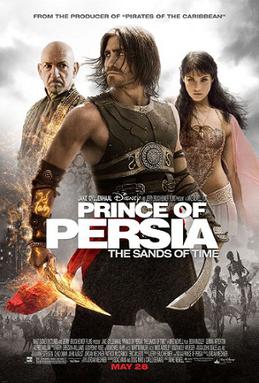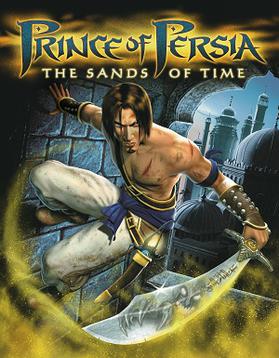Okay, much to cover, so let’s crank.
For starters, we have my review of the videogame adaptation of Prince of Persia: The Sands of Time, titled, appropriately enough, Prince of Persia: The Sands of Time at SF Signal.
Though I have not seen many, and thus am hardly an expert, I would venture a guess that Prince of Persia: The Sands of Time is the best film adaptation of a video game since the subgenre was inaugurated in 1993 by Super Mario Bros. Considering how wretched virtually all video game movies have been, from Street Fighter and Lara Croft: Tomb Raider to recent travesties like Hitman and Max Payne, one would make the reasonable assumption that this does not mean the most recent entry is good, and one would be right. In spite of this, it manages to be more enjoyable than it has any right to be, despite its lack of originality and its forgettable execution.
Granted, writers Jordan Mechner, Boaz Yakin, Doug Miro and Carlo Bernard must put their characters (such as they are) through similar machinations as those in the game, which keeps their plot mired in situations all too familiar to most fans of adventure and fantastic literature, but Mike Newell’s direction often shows enough professionalism to engage the audience, taking his cues not from the game’s third person acrobatics but movie serials from the 1930s and 1940s. Often, but not consistently; action sequences frequently lapse into slow motion (all too common in action movies today) and its aesthetics never rise above the point of view of a video game, making the viewer feel as if the seat should come equipped with a PlayStation 2 controller. Its attempts to become a modern day serial thus fall short of the same noble goal reached by Steven Spielberg’s Raiders of the Lost Ark.

Also up at SF Signal is my review of Vincenzo Natali’s new B-pic Splice, which despite its timeliness strikes me as the worst mad scientist movie in a long while, even beating out John Frankenheimer’s wretched The Island of Dr. Moreau.
From the time Mary Shelley created the first, elemental modern Prometheus in 1818, the mad scientist has become such a standard trope in the science fiction genre, so often used, as often parodied, that it cannot even be called a cliché. In a way, since Frankenstein’s initial publication, its titular character has become the nodal point for any creative artist who wishes to tell the story of scientific progress gone amok, with the underlying message that There Are Things Man Was Not Meant to Know. Indeed, one could make the argument that most science fiction primarily is a retelling of the classic tale.
Given that, one should not be surprised to see Mary Shelley’s considerable influence in Splice. And it says quite a bit that moments of Splice show a debt to not only Frankenstein but also to the oeuvre of Cronenberg. (The movie was shot in Toronto, the location of many of Cronenberg’s films.)
But somewhere between the story by Vincenzo Natali and Anoinette Terry Bryant and the screenplay by Natali, Bryant and Doug Taylor, something goes as wrong as the Frankenstein story it tries to tell.

Lastly, Installment Two of my column “Watching the Future” is up at SF Site. This time your humble columnist travels back to Memorial Day weekend 1980, taking stock of the changes movie has undergone since the release of The Empire Strikes Back.
I cite The Empire Strikes Back as my first real love of cinema. I had seen movies before — like most members of my generation, the original Star Wars heavily influenced my taste in 1977, Roger Moore’s two recent James Bond movies, The Spy Who Loved Me and Moonraker, though nearly unwatchable for me today, fueled my imagination, and of course Richard Donner’s Superman took me to comic book nirvana. Sure, I liked movies, but until The Empire Strikes Back I never thought about going to the movies. I went to a theater, but had not adopted the rituals. And, like most rituals, they are becoming obscure to the point of endangerment.
It was as codified as a Noh play. One might complain about the cost of the ticket, or the price of the food. If it was summer and you had nothing else to do and thought you could get away with it, you might try sneaking into another showing after your movie was done (or, if you were under seventeen, try sneaking into an R-rated movie). For a major event movie, you might have to wait in line for several hours before catching a screening (as we did for The Empire Strikes Back), and even then having no guarantee that you would see it at the time you wanted. Every now and then, you might decide to see a movie on a whim, so you might drive to the theater and watch anything that had an interesting poster and started soon. Nonetheless, for the true cinephile, this ritual had the same reverence as a devout Catholic attending mass. Movie theaters, even the bad ones, were our churches, and we could become upset at any disruption.

And there will be more. I would love to discuss Margaret Atwood’s recent announcement that yes, indeed, she has written science fiction, despite the fact that a number of science fiction writers have likely exhausted this topic, but I want to let it sit for a little while so that I can make a coherent, reasonable observation, instead of the knee-jerk response that is too often the hallmark of the blogosphere.
More soon.
















